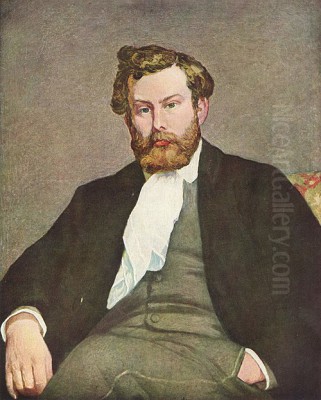
Alfred Sisley stands as one of the most dedicated and sensitive landscape painters of the Impressionist movement. Born in Paris to British parents, he spent almost his entire life in France, yet remained a British citizen. His artistic journey placed him at the heart of Impressionism, alongside friends like Claude Monet and Pierre-Auguste Renoir. Despite facing significant financial hardship and a lack of widespread recognition during his lifetime, Sisley created a body of work celebrated for its lyrical beauty, subtle rendering of light and atmosphere, and profound connection to the French countryside. He is often regarded as one of the purest adherents to the original Impressionist ideals, focusing almost exclusively on capturing the fleeting effects of nature en plein air.
From Commerce to Canvas: Early Life and Artistic Calling
Alfred Sisley was born in Paris on October 30, 1839. His parents, William Sisley and Felicia Sell, were affluent British expatriates. William was a successful businessman involved in the silk trade, operating between England and France, while Felicia was a knowledgeable music connoisseur. This comfortable background provided Sisley with a cultured upbringing. As expected for a son of a businessman, he was sent to London in 1857, at the age of 17, to pursue studies in commerce, presumably to prepare him for a role in the family business.
However, his four years in London (1857-1861) proved formative in a different way. Instead of dedicating himself to business, Sisley immersed himself in the city's art scene. He frequented museums and galleries, developing a passion for painting. He was particularly drawn to the works of British landscape masters like J.M.W. Turner and John Constable, whose approaches to light and atmosphere likely resonated with his developing sensibilities. This exposure solidified his desire to become an artist.
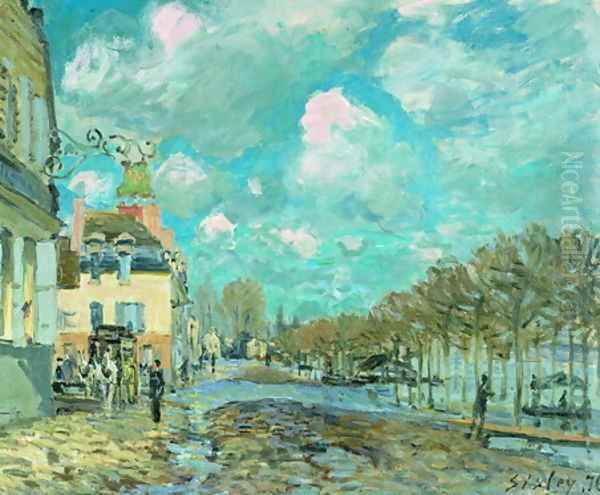
Upon returning to Paris around 1861, Sisley abandoned the path of commerce and committed himself to art. He entered the studio of the Swiss academic painter Charles Gleyre. While Gleyre's own style was traditional, his studio became an unexpected crucible for Impressionism. It was here that Sisley met fellow students who would become his lifelong friends and collaborators: Claude Monet, Pierre-Auguste Renoir, and Frédéric Bazille. This group shared a growing dissatisfaction with the rigid conventions of academic art taught in the studio and promoted by the official Paris Salon.
The Impressionist Circle: Friendship and Shared Vision
The friendships forged in Gleyre's studio were pivotal for Sisley and the nascent Impressionist movement. Sisley, Monet, Renoir, and Bazille formed a close-knit group, united by their desire to paint modern life and, crucially, to capture the transient effects of light and atmosphere directly from nature. They began venturing out of the studio to paint en plein air (outdoors), particularly in the Forest of Fontainebleau near the village of Barbizon, following in the footsteps of earlier landscape painters like Jean-Baptiste-Camille Corot and Théodore Rousseau of the Barbizon School.
This practice of outdoor painting became a cornerstone of Impressionism. It allowed artists to observe and record the nuances of natural light and color with unprecedented immediacy. Sisley, with his innate sensitivity to landscape, embraced this approach wholeheartedly. He, along with Monet and Renoir, began developing the characteristic techniques of Impressionism: broken brushwork, a brighter palette, and an emphasis on capturing the sensation of a scene rather than a detailed, photographic representation.
Sisley began submitting works to the official Paris Salon, the primary venue for artists to gain recognition and patronage. He achieved some early success, having paintings accepted in 1866, 1868, and 1870. However, like his friends, he often faced rejection from the conservative Salon jury. This shared frustration, coupled with their evolving artistic vision, led the group, which now included artists like Camille Pissarro, Edgar Degas, and Berthe Morisot, to organize their own independent exhibitions, bypassing the official system. Sisley participated in the first Impressionist exhibition in 1874, and subsequently in those of 1876, 1877, and 1882, cementing his place within the movement's core.
Capturing Light and Atmosphere: Sisley's Artistic Style
Alfred Sisley was, above all, a landscape painter. Unlike Monet, who occasionally painted portraits and still lifes, or Renoir and Degas, who frequently depicted figures and urban scenes, Sisley remained almost exclusively devoted to the landscape throughout his career. His primary subject was the countryside around Paris, particularly the regions along the Seine and Loing rivers – areas like Louveciennes, Marly-le-Roi, Sèvres, Veneux-Nadon, and later, Moret-sur-Loing.
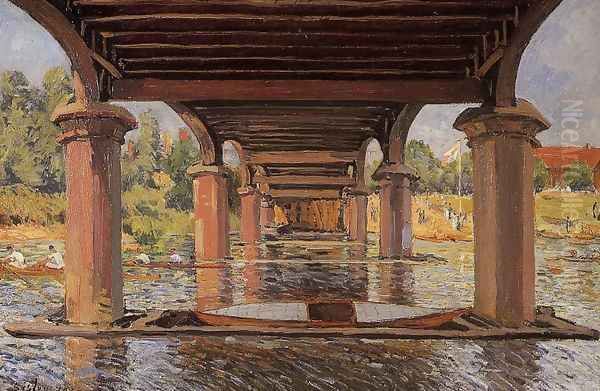
His style is characterized by a remarkable sensitivity to the subtleties of light, weather, and season. He possessed an extraordinary ability to capture the delicate atmosphere of a particular moment – the crisp air of a winter morning, the hazy light of a spring afternoon, the dramatic skies before a storm, or the tranquil reflections on water. Water and sky are dominant elements in his work, often occupying large portions of the canvas, allowing him to explore the ever-changing play of light and reflection.
Influenced by Corot's lyrical landscapes and potentially by the atmospheric effects in the works of Turner and Constable seen during his time in London, Sisley developed a distinctive palette. While employing the brighter colors typical of Impressionism, his tones are often more delicate and harmonious than those of Monet or Renoir. He favored soft blues, greens, lilacs, pinks, and creamy whites, using subtle tonal variations to render light and shadow. His brushwork, while recognizably Impressionist in its broken application, can appear more controlled and less vigorous than Monet's, contributing to the overall sense of tranquility and order in his compositions.
Sisley often structured his landscapes with receding paths, rivers, or rows of trees, creating a sense of depth and inviting the viewer into the scene. His compositions feel natural and unforced, reflecting his direct observation of nature. He excelled at painting snow scenes, capturing the unique way light reflects off snow and the muted colors of a winter landscape. Similarly, his depictions of floods, like the series at Port-Marly, convey the power of nature while retaining a sense of atmospheric beauty. His work consistently evokes a feeling of peace, harmony, and a deep, almost poetic connection to the natural world.
Signature Works: Painting the Île-de-France
Throughout his career, Sisley produced a consistent body of high-quality work, focusing on the landscapes he knew intimately. Several paintings stand out as representative of his style and mastery:
Floods at Port-Marly (1876): This is perhaps one of Sisley's most famous works, part of a series depicting the flooding of the Seine. It showcases his ability to capture the reflective quality of water, even under dramatic circumstances. The vast expanse of water mirrors the sky and buildings, creating a scene that is both realistic in its depiction of the flood and poetically atmospheric. The brushwork is fluid, conveying the movement of the water and the dampness of the air.
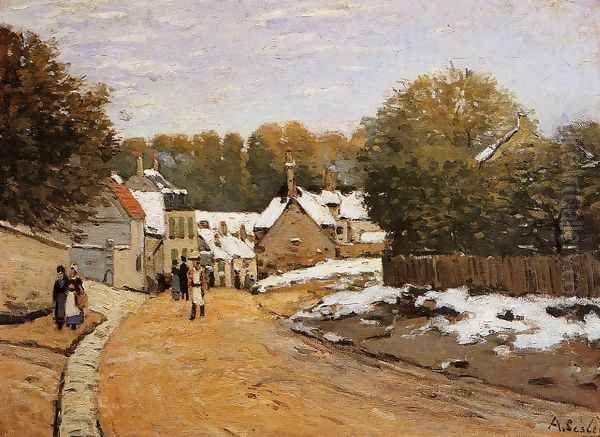
The Bridge at Hampton Court (1874): Painted during a brief visit to England (funded by a patron, Jean-Baptiste Faure), this work depicts the bustling scene near Hampton Court Palace outside London. It shows Sisley applying his Impressionist techniques to a different environment, capturing the light on the Thames and the activity on the bridge and riverbanks. It remains one of the few major works painted outside France.
Snow at Louveciennes (c. 1875-1878): Sisley painted numerous snow scenes, becoming a master of the motif. This particular work (and others like it) demonstrates his skill in rendering the subtle colors and light effects of snow. Far from being just white, the snow reflects the blues, pinks, and greys of the winter sky, and the bare trees create delicate patterns against the landscape. These works convey a sense of quiet stillness unique to winter.
The Seine at Point du Jour (1878): This painting exemplifies Sisley's fascination with the river Seine. It captures the light on the water, the reflections of the sky, and the gentle activity along the riverbanks. The composition often features a high horizon line, emphasizing the expanse of water and sky, key elements in Sisley's exploration of atmospheric effects.
Moret Church (various, e.g., The Church at Moret, 1893-1894): In his later years, living in Moret-sur-Loing, Sisley painted the town's medieval church repeatedly, much like Monet painted Rouen Cathedral. He depicted it from different viewpoints and under various light conditions – in morning sun, afternoon haze, or winter snow. These works show his sustained engagement with a single motif to explore the nuances of light and atmosphere.
Springtime in the Little Pasture / Les Petits Prés au Printemps (1884): This work captures the freshness and burgeoning life of spring. The delicate greens of new foliage, the soft light, and the tranquil pastoral scene are characteristic of Sisley's gentle and optimistic depictions of the changing seasons.
These works, among many others, highlight Sisley's consistent dedication to landscape, his mastery of light and color, and his ability to imbue scenes of the French countryside with a quiet, lyrical beauty.
Trials and Tribulations: A Life of Modest Means
Despite his talent and his central role in the Impressionist movement, Alfred Sisley's life was marked by persistent financial difficulties. The comfortable circumstances of his youth ended abruptly with the Franco-Prussian War of 1870-1871. The war devastated the French economy and ruined his father's business. William Sisley died shortly thereafter, leaving Alfred without the family allowance he had previously relied upon.
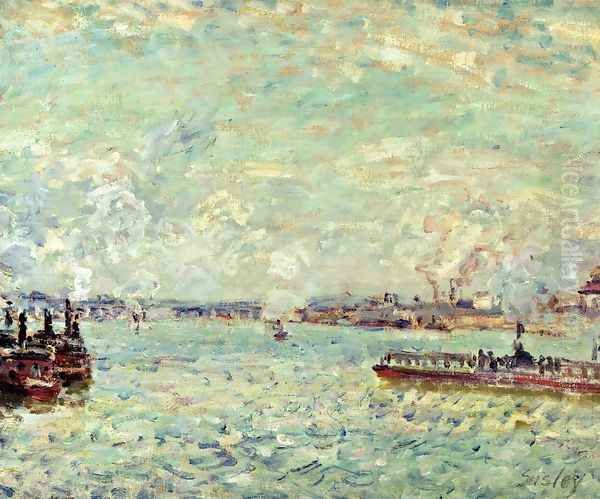
From this point forward, Sisley had to support himself and his family (he had a long-term partner, Eugénie Lesouezec, later his wife, and two children) solely through the sale of his paintings. This proved incredibly challenging. While Impressionism was gaining some critical attention, the market for their work was small and inconsistent. Patrons were few, and prices were often low. Art dealers like Paul Durand-Ruel provided crucial support to Sisley and other Impressionists, buying works and organizing exhibitions, but sales remained sporadic.
Sisley's gentle personality and perhaps his British reserve might have made him less adept at self-promotion than some of his contemporaries. He rarely achieved the prices commanded by Monet or Renoir later in their careers. Consequently, Sisley lived most of his adult life in relative poverty. The family frequently moved to cheaper lodgings in villages outside Paris, including Louveciennes, Marly-le-Roi, Sèvres, and eventually settling near Moret-sur-Loing. Letters reveal his constant struggle to make ends meet, often appealing to friends or patrons for small loans or assistance.
Adding to his sense of displacement, perhaps, was his nationality. Despite living almost his entire life in France and contributing significantly to a major French art movement, Sisley remained a British citizen. He applied for French citizenship twice, in 1885 and 1897, but both applications were unsuccessful, reportedly due to bureaucratic hurdles or lost paperwork. He died a British subject in the country he had painted so devotedly. This lifelong financial struggle and lack of widespread recognition stand in stark contrast to the serene beauty and artistic accomplishment evident in his work.
Finding Solace in Moret: The Final Chapter
In 1880, Sisley and his family moved to Veneux-Nadon, and shortly after, in 1882, they settled permanently in the vicinity of Moret-sur-Loing, a picturesque medieval town situated southeast of Paris near the Forest of Fontainebleau. This area, with its tranquil river, ancient bridge, imposing church, and surrounding countryside, provided Sisley with endless inspiration for the remainder of his life. He seemed to find a deep connection with this specific landscape, painting it repeatedly with affection and sensitivity.
His paintings from the Moret period often display a continued fascination with the effects of light on the Loing river and the town's architecture. His series of paintings depicting the Moret church under different conditions is a testament to his sustained observational powers, akin to Monet's series paintings of haystacks or Rouen Cathedral. Some art historians note a slight shift in his later work, occasionally using bolder colors or more textured brushwork, perhaps reflecting the broader evolution of painting styles at the end of the 19th century, though he never abandoned his core Impressionist principles.
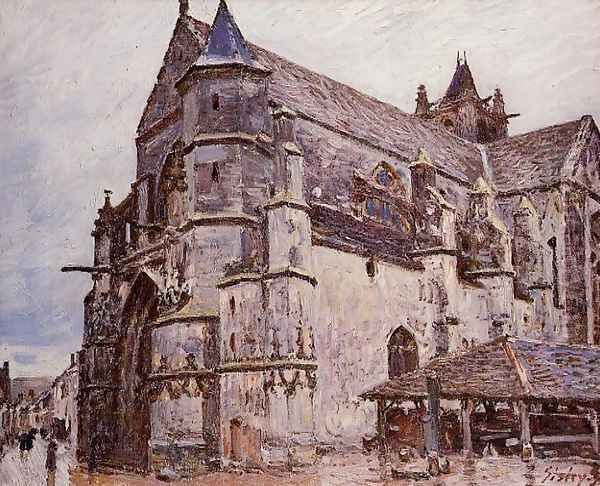
Despite his ongoing financial struggles, his later years in Moret were artistically productive. He continued to paint diligently, capturing the familiar landscapes around him with enduring freshness. In 1897, he finally married his long-term partner, Eugénie Lesouezec (also known as Marie Lesouezec), shortly before another failed attempt to gain French citizenship.
Tragically, Sisley's life was cut short. He developed throat cancer and died in Moret-sur-Loing on January 29, 1899, at the age of 59. His wife, Eugénie, who had also been ill, died just a few months later. He passed away just as Impressionism was beginning to gain wider acceptance and market success, a recognition he himself never fully enjoyed during his lifetime. Monet, learning of Sisley's illness and poverty, organized a benefit auction to support Sisley's children.
Sisley Among Contemporaries: Unique Voice in a Chorus
Sisley's position within the Impressionist group was unique. He was a core member from the early days in Gleyre's studio, sharing the group's revolutionary aims and participating in their key exhibitions. His friendships, particularly with Monet and Renoir, were deep and lasting. He painted alongside Monet at Argenteuil and other locations, sharing motifs and exploring the challenges of capturing light on water. Renoir painted sensitive portraits of Sisley and his family, attesting to their close bond.
However, Sisley's artistic focus and perhaps his temperament set him slightly apart. While Monet's work grew increasingly abstract in its focus on light and color, and Renoir shifted towards more classical figure painting later in his career, Sisley remained steadfastly committed to representing the landscape before him with fidelity to light and atmosphere. His dedication to landscape was perhaps only matched by Camille Pissarro, another stalwart Impressionist landscapist.
Compared to the often dazzling brilliance of Monet or the sensuous richness of Renoir, Sisley's art possesses a quieter, more introspective quality. His paintings rarely shout for attention; instead, they invite contemplation through their subtle harmonies and delicate rendering of mood. This consistency and focus led critics and historians to label him one of the "purest" Impressionists, the one who perhaps deviated least from the movement's initial landscape-focused, plein-air principles. While he may have been overshadowed commercially by some of his peers during his lifetime, his unique voice – gentle, lyrical, and deeply attuned to nature – holds a distinct and valued place within the Impressionist chorus.
A Lasting Impression: Sisley's Legacy
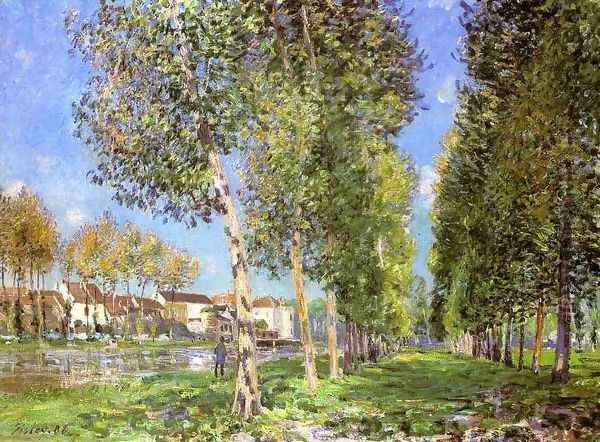
Although Alfred Sisley died in relative obscurity and poverty, his artistic reputation began to grow steadily in the years following his death. As Impressionism gained historical importance and widespread public appreciation in the early 20th century, Sisley's significant contribution became increasingly recognized. Critics and collectors began to appreciate the consistent quality, technical skill, and poetic sensitivity of his work.
His influence can be seen in the continuation of landscape painting traditions. His dedication to capturing specific light and atmospheric conditions, his subtle use of color, and his harmonious compositions offered a model for subsequent generations of landscape artists, even as styles evolved towards Post-Impressionism and beyond. While direct influence is sometimes hard to trace, his work resonates with the landscape concerns of artists who followed, including potentially informing the structural concerns of Paul Cézanne or the expressive color of Vincent van Gogh, both of whom built upon Impressionist foundations. His connection to the Barbizon school through his plein-air practice also links him to foundational figures like Corot, Rousseau, Millet, and Daubigny.
Today, Alfred Sisley is acknowledged as a major figure of Impressionism. His paintings are highly sought after and are held in the collections of major museums around the world, including the Musée d'Orsay in Paris, the National Gallery in London, the Metropolitan Museum of Art in New York, and many others. Exhibitions dedicated to his work continue to draw audiences, captivated by the serene beauty and timeless appeal of his landscapes.
His legacy lies in the body of work he left behind – hundreds of paintings that celebrate the beauty of the French countryside, particularly the Île-de-France region he loved so much. He remains a testament to artistic dedication in the face of adversity, a painter who quietly pursued his vision, capturing the fleeting moments of nature with unparalleled grace and sensitivity.
The Quiet Observer: Sisley's Place in Art History
Alfred Sisley occupies a distinct and essential place in the history of Impressionism and landscape painting. As a British artist deeply embedded in the Parisian avant-garde, his perspective was unique. He was a founding member of the movement, a close friend of its leading figures, and a consistent practitioner of its core tenets, particularly the commitment to plein-air painting and the study of light.
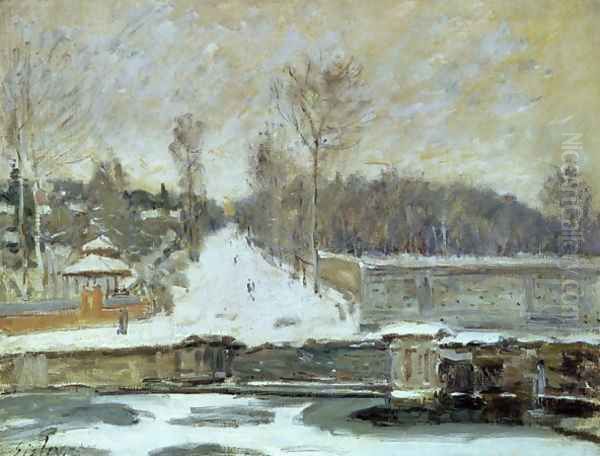
While he lacked the commercial success and perhaps the overt stylistic innovations of Monet or Renoir, his unwavering focus on landscape allowed him to achieve a profound depth and sensitivity in his chosen genre. His paintings are not merely records of places, but evocative renderings of atmosphere, mood, and the subtle poetry of the natural world. He captured the rivers, skies, fields, and villages of France with a gentle lyricism that remains deeply affecting.
His life story, marked by financial hardship and a lack of contemporary fame, underscores the often-difficult path of artistic innovation. Yet, through these challenges, he produced a remarkably consistent and beautiful body of work. Alfred Sisley endures as the quiet observer of Impressionism, the artist who, perhaps more than any other, dedicated his life to capturing the tranquil, light-filled essence of the landscape. His paintings continue to offer moments of peace and beauty, securing his legacy as a master of Impressionist landscape.